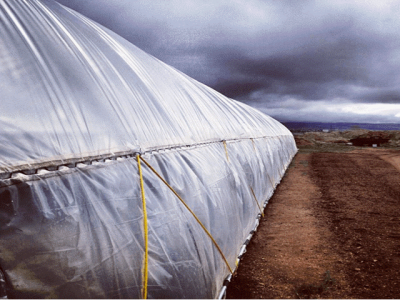The 4 Best Ways to Cool a Greenhouse

Here on the high plains of Wyoming, our summers are cool and dry. We rarely need cooling, but when we do, we can just use fans and passive ventilation.
Not everyone has a simple option, however. Each greenhouse and farm has its own advantages and set of needs.
For instance, hot and humid places need cooling methods for greenhouses that won’t add even more water to the air. (High humidity is a huge “come on in!” to many pests and pathogens.)
Like with any decision, each cooling method has its limits and tradeoffs that growers must balance; a method might work very well but impose a limitation elsewhere. This doesn’t mean that the method is not worth using, but growers who are aware of those tradeoffs will run healthier, more productive greenhouses.
4 ways to cool a greenhouse
1) Shade Cloth
The first method recommended for greenhouse managers is shade cloth. Shade cloth or shade curtains are quite affordable and can lower temperatures by up to 10 degrees.
The tradeoff that managers will have to balance with shade cloth is between lowering temperatures and losing some production with the light that is being blocked. (You can get shade cloth at Greenhouse Megastore.)

2) Evaporation (Cooling Walls)
Depending on the level of humidity you have in your area, evaporative cooling can be a good cost-effective method for you.
You can buy the pads for a cooling wall online through Greenhouse Megastore, and make your own wall with some PVC, 2X4’s and a small sump tank.

3) Ventilation
Ventilation using roll-up sidewalls or open roof ventilation. Ryan Wilcott at Stuppy Greenhouses describes how this ventilation works to lower temperatures in a greenhouse:
“ As cool air enters either through outside air or artificial cooling, the warm air rises and escapes through roof vents. (Advanced planning wins out here – know where the prevailing winds are coming from before building the structure.)”

4) Circulation (fans)
Circulating fans are a must for any grower to keep air moving for gas exchange and temperature consistency. In greenhouses, circulating fans help push warm air out and cool air down.

Start with the simple and low cost methods
There are a few other ways to cool a greenhouse, such as geothermal heating and chillers. We’ve found, however, that the cost of buying and running equipment associated with those methods are far too high to be effective in most situations.
As with other management goals, start with the practices with low labor and financial costs. Strategically ventilating the greenhouse and keeping certain components underground, for example, can contribute to cooling, and they cost very little.
Each greenhouse needs a specific amount and type of cooling
Remember that cooling needs vary based on location, orientation, and greenhouse type!
Think about how air is already moving in and around your farm, how your farm is shaded or insulated, and work with it.
Ryan Wilcott leaves us with a tip regarding this variability: “If your heating & cooling supplier is not asking for house dimensions, geographic and temperature variance information then this should be a huge red flag. All are important factors in calculating efficiency and could drastically affect yields.”
Có thể bạn quan tâm
Phần mềm

Phối trộn thức ăn chăn nuôi

Pha dung dịch thủy canh

Định mức cho tôm ăn

Phối trộn phân bón NPK

Xác định tỷ lệ tôm sống

Chuyển đổi đơn vị phân bón

Xác định công suất sục khí

Chuyển đổi đơn vị tôm

Tính diện tích nhà kính

Tính thể tích ao hồ




 Deeper roots, better carrots
Deeper roots, better carrots  Making Cucurbitaceae weed-control easier
Making Cucurbitaceae weed-control easier